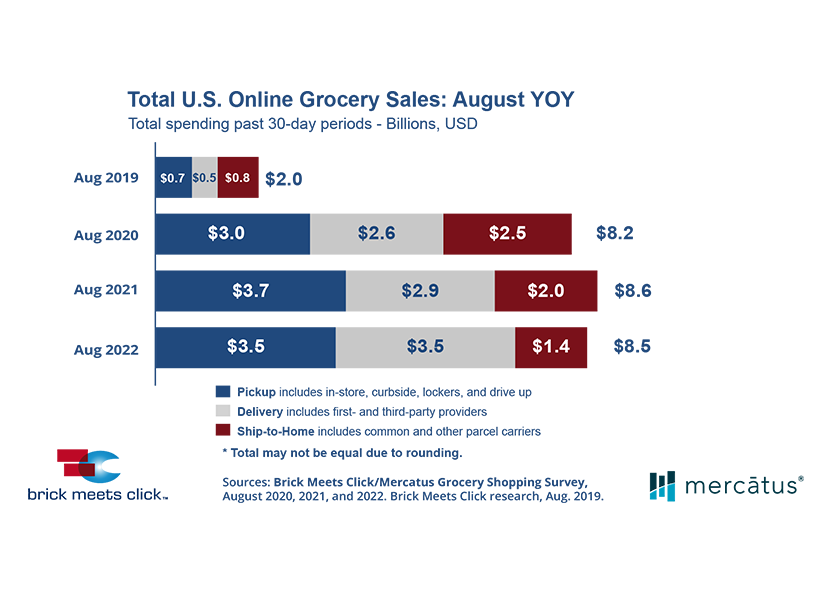August e-grocery sales slip by almost 1% versus year ago

Total U.S. online grocery sales in August slipped by less than 1% compared to August 2021, to $8.5 billion for the month, according to the Brick Meets Click/Mercatus Grocery Shopping Survey fielded Aug 29-30.
Despite this small year-over-year dip, monthly shopper research during the last four years shows that e-grocery sales have remained at “significantly elevated” levels following the dramatic surge at the start of the COVID-19 pandemic, according to a news release.
Because overall online grocery sales quadrupled to $8.2 billion in August 2020 from pre-pandemic levels, these sales have stabilized at even higher levels, finishing at $8.6 billion for August 2021 and $8.5 billion for August 2022.
Shifts in receiving online orders
But shifts in the way households shop online for groceries have changed the competitive landscape.
While the three segments — pickup, delivery and ship-to-home — have each grown since pre-pandemic, the share of sales has migrated away from ship-to-home, with delivery consistently growing year over year and pickup also growing but ceding a small share in August 2022 versus 2021.
“The COVID pandemic motivated trial of delivery and pickup services at a scale that no one could have predicted,” Brick Meets Click partner David Bishop said in the release. “And, as the pandemic evolves, it’s increasingly clear that many households find online grocery shopping an acceptable option to complement their new in-store shopping behaviors.”
In August 2022, more than 68 million households went online to buy at least one grocery order. Although the total base of monthly active users for August 2022 is down by a little more than 1% versus 2021, it’s still up 23% from 2020 and 116% compared to 2019, according to the release.
As the base of these monthly users has grown, the demand for specific receiving methods has continued to shift from pre-pandemic behaviors. The share of users choosing ship-to-home dropped from 58% in 2019 to 44% in 2022. Over the same time period, delivery’s share of users climbed from 25% to 44%, and pickup expanded from 32% to 54%.
These users are also shopping online more frequently, although the year-over-year trends since pre-pandemic are slightly different. Between August 2019 and August 2020, the average number of orders received by a monthly user jumped by 40%, from 2.0 to 2.8; since then, it has gradually declined to 2.7 in August 2021 and 2.6 in August 2022. “This downward trend in order frequency is largely the result of a growing [monthly active user] base that is still influenced to some degree by concerns about catching the virus,” Bishop said.
Inflation influence
Weekly grocery spending for August 2022 does show signs of inflationary pressures versus the prior year. But that’s partly due to where customers are shopping, as well as the size of the average order. Overall grocery spending in August was up 14% compared to a year ago as households reported spending just over $200 during the most recent seven-day period, according to the release.
The likelihood that an online grocery shopper will use the same service again within the next month has remained extremely stable during 2022, finishing August at 63%. This is three points higher compared to 2021, although it still trails the two earlier years by almost 10 points.
And, while the overall year-over-year view is positive, grocery retailers continued to lag behind mass retailers — such as Walmart and Target — on this metric by nearly 10 points for August.
The wide and persistent gap in repeat intent between grocery retail and mass retail is especially concerning because cross-shopping between the two formats remained elevated at 29% in August, three points higher than last year and 11 and 14 points higher compared to 2020 and 2019 respectively.
This suggests that grocery operators need to focus on closing this gap by improving various aspects of the online shopping experience, ranging from how orders are placed to when they are received.
“The strategies that mass retailers use are difficult for most grocery retailers to imitate for various reasons,” Mercatus President and CEO Sylvain Perrier said in the release. “Price inflation plays to their competitive advantage, but only up to a point as online shopping still is about convenience. Conventional grocers should emphasize the cost savings and convenience of their pickup services. At the same time, consider implementing a variable service fee structure that offers customers more control over the extra costs and grocers better ways to lower costs through operational efficiencies.”
For information about access to the research and monthly eShopper/eMarket report, go to brickmeetsclick.com.







